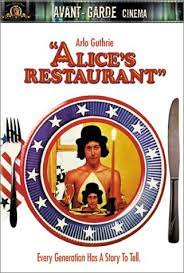
ALICE'S RESTAURANT
US, 1969, 110 minutes, Colour.
Arlo Guthrie, Pat Quinn, James Broderick, Pete Seeger.
Directed by Arthur Penn.
Alice's Restaurant was Arthur Penn's (The Chase, Bonnie and Clyde, Little Big Man) look at the youth revolution of the 1960's. It starred Arlo Guthrie and was based on his ballad of the massacre at Alice's Restaurant. Penn had a look at the hang-ups of young America, the reactions of older America and some of the searches for solutions. It needs to be considered alongside Easy Rider, Zabriskie Point, Woodstock and similar films of 1969-70 to see how these films were forceful comments, but still parentheses, in the statements about the condition of the U.S.
The film was popular in the United States, where it made more immediate impact on the situation and where Arlo Guthrie was better known. The film may date more quickly than most but it is an interesting, if sometimes annoying, film. Young audiences went eagerly to see it, but judging from reactions, did not understand much of what was going on except the songs, Arlo and his friends and the police baiting. They rushed out of the theatres before the sombre conclusions; they did not see the scene, let alone ask themselves why Alice stood for minutes silently outside the church after the revels. Alice's Restaurant caught a real American mood.
1. The main personalities in the film - Arlo, Alice, Ray, Shelley, Roger, the girls - why were they likeable (or not) and whether the film made them out to be completely attractive and sympathetic.
2. What did the film say about America, American youth, drop-outs, drugs, cars, bikes and death, the army draft?
3. Discuss the words of Arlo Guthrie's The Massacre at Alice's Restaurant - how did the film visualise them, and how effectively?
4. Discuss Alice and Ray's ambitions with the church, the restaurant and whether they were realistic, and why Alice remained standing at the church door after the revels of the renewal of marriage. What did the director communicate by this lengthy finale (some critics have likened it to Prospero's speech, "Our revels now are over..." in The Tempest)?
5. Did the film criticise the U.S. police? Strongly? Was the littering scene funny? Does it make any difference to you to know that the real officer Obie played himself?
6. Discuss the film and its ideas on love, peace, freedom, community, 'doing your own thing', learning and growing up and growing older. Arlo says at the end of the film that he has not found himself yet; Ray is off on another idealistic scheme.
7. Discuss the effect of the Woody Guthrie sick-bed scenes, Arlo's presence there and Pete Seeger's singing.
8. Other elements worth discussing:
- Roger's dropping out.
- Arlo's attitude to education, to training to be a musician.
- Shelley's addiction, love for Alice, the help his friends offer, his death,
- the symbolism of the church, although it had been secularised.
- the enterprise of the restaurant and Alice's hard work and exhaustion.
- the satire on law and freedom in the littering case, and in Arlo's call-up (especially the words of the ballad at this stage).
the humanising influence of Woody's illness and the fact that Arlo knew that it was hereditary, it could be his death.
9. After discussing the film, do you feel that it was a good film, an important film?